The ancient Egyptian cities of Canopus and Thonis-Heracleion sat on the seabed of the Abukir Bay for over a thousand years before pioneering archeologist Franck Goddio began excavating in 2001. Now his finds are part of an upcoming exhibition at the British Museum in London: Sunken Cities: Egypt's Lost Worlds.

Canopus and Thonis-Heracleion are interesting to historians due to their location during a time of cultural cross-pollination. Key trading ports, they would receive boats from Greece and gradually developed an immigrant community, who built their own temples and worshiped their own gods.
Ancient cities rise from the sea-2
Canopus and Thonis-Heracleion are interesting to historians due to their location during a time of cultural cross-pollination. Key trading ports, they would receive boats from Greece and gradually developed an immigrant community, who built their own temples and worshiped their own gods.

A colossal statue of the god Hapy, made from pink granite, stands over 16-feet tall and is 12,000 pounds.
Ancient cities rise from the sea-3
A colossal statue of the god Hapy, made from pink granite, stands over 16-feet tall and is 12,000 pounds.
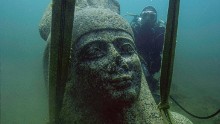
Hapy, god of the flooding of the Nile, was a symbol of abundance and fertility. The example on display dates from the Early Ptolemaic period. During that time, the Greek rulers of Canopus and Thonis- Heracleion commissioned statues of their likeness, though they also made sure to feature Egyptian affectations.
Ancient cities rise from the sea-4
Hapy, god of the flooding of the Nile, was a symbol of abundance and fertility. The example on display dates from the Early Ptolemaic period. During that time, the Greek rulers of Canopus and Thonis- Heracleion commissioned statues of their likeness, though they also made sure to feature Egyptian affectations.

The stele of Thonis-Heracleion, found by Goddio's team, is an artifact that helped consolidate Ptolemaic rule. Inscribed with the decree of Saϊs and commissioned by Nectanebos I (378-362 BC), the text describes trade and taxation agreements and details royal beneficiaries.
Ancient cities rise from the sea-5
The stele of Thonis-Heracleion, found by Goddio's team, is an artifact that helped consolidate Ptolemaic rule. Inscribed with the decree of Saϊs and commissioned by Nectanebos I (378-362 BC), the text describes trade and taxation agreements and details royal beneficiaries.
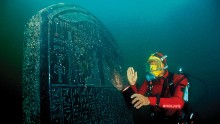
The intact stele is over six feet tall and was carefully removed by Goddio's team for preservation.
Ancient cities rise from the sea-6
The intact stele is over six feet tall and was carefully removed by Goddio's team for preservation.
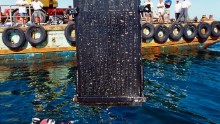
Goddio's team and a six-and-a-half-foot long pink granite garden vat dating from the fourth-to-second century BC. The ports became submerged through a variety of factors, including rising sea levels, subsidence, tidal waves and land liquefaction.
Ancient cities rise from the sea-7
Goddio's team and a six-and-a-half-foot long pink granite garden vat dating from the fourth-to-second century BC. The ports became submerged through a variety of factors, including rising sea levels, subsidence, tidal waves and land liquefaction.
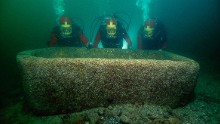
Ptolemaic rulers were not fans of animal worship, and so reconstituted gods such as the all-powerful bull Apis into Serapis, a god with a Grecian appearance which was disseminated throughout temples in Egypt.
Ancient cities rise from the sea-8
Ptolemaic rulers were not fans of animal worship, and so reconstituted gods such as the all-powerful bull Apis into Serapis, a god with a Grecian appearance which was disseminated throughout temples in Egypt.
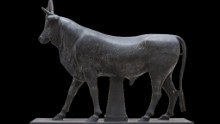 Bulls were sacrificed as part of the cult of Apis, and archeologists discovered bovid remains on the seabed in Canopus.<br /><br />
Bulls were sacrificed as part of the cult of Apis, and archeologists discovered bovid remains on the seabed in Canopus.<br /><br />Ancient cities rise from the sea-9
Bulls were sacrificed as part of the cult of Apis, and archeologists discovered bovid remains on the seabed in Canopus.
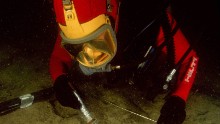
Canopus and Thonis-Heracleion also yielded intricate jewelry, says Masson-Berghoff. Seen here is a pectoral in gold, lapis lazuli and glass paste, found in Tanis in the royal tomb of the Pharaoh Sheshonk II. In the center of the piece is a barge, not unlike the 69 vessels discovered by Goddio's team in Abukir Bay.
Ancient cities rise from the sea-10
Canopus and Thonis-Heracleion also yielded intricate jewelry, says Masson-Berghoff. Seen here is a pectoral in gold, lapis lazuli and glass paste, found in Tanis in the royal tomb of the Pharaoh Sheshonk II. In the center of the piece is a barge, not unlike the 69 vessels discovered by Goddio's team in Abukir Bay.
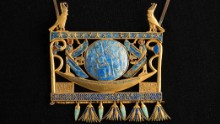
To follow us on twitter click @iReporterng
To Like our facebook fan page click iReporter on Facebook
Join Us on BBM Channel Add Pin or click: C00224051
Report News as its UNFOLDS via: ireporterng@gmail.com



















No comments:
Post a Comment
Subscribe to our publication. Do not miss out on any information.
Join us on Facebook:
https://facebook.com/ireporterinternational
Follow us on Twitter:
https://twitter.com/ireporterng
Note: Only a member of this blog may post a comment.